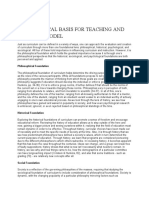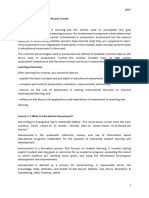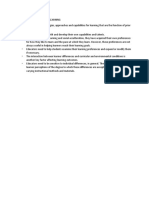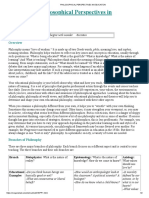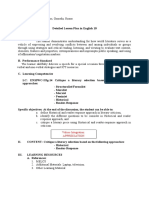100%(1)100% found this document useful (1 vote)
456 viewsPlacement Assessments
Placement Assessments
Uploaded by
Pajarillo John Mark D.Placement assessments are used before a course begins to determine a student's current skills and knowledge in subjects like reading, writing, and math. This information is used to match students with courses at an appropriate level to meet their individual needs. Diagnostic assessments also test a student's existing knowledge before a unit or topic, in order to inform lesson planning and identify areas for teachers to spend more or less time on. They are low-stakes and do not count towards a student's grade. Examples include pre-tests on Ancient Greece given to see what background knowledge students have on its geography, history, and culture.
Copyright:
© All Rights Reserved
Available Formats
Download as DOCX, PDF, TXT or read online from Scribd
Placement Assessments
Placement Assessments
Uploaded by
Pajarillo John Mark D.100%(1)100% found this document useful (1 vote)
456 views2 pagesPlacement assessments are used before a course begins to determine a student's current skills and knowledge in subjects like reading, writing, and math. This information is used to match students with courses at an appropriate level to meet their individual needs. Diagnostic assessments also test a student's existing knowledge before a unit or topic, in order to inform lesson planning and identify areas for teachers to spend more or less time on. They are low-stakes and do not count towards a student's grade. Examples include pre-tests on Ancient Greece given to see what background knowledge students have on its geography, history, and culture.
Original Description:
Hi I hope this helps.
Original Title
Placement assessments
Copyright
© © All Rights Reserved
Available Formats
DOCX, PDF, TXT or read online from Scribd
Share this document
Did you find this document useful?
Is this content inappropriate?
Placement assessments are used before a course begins to determine a student's current skills and knowledge in subjects like reading, writing, and math. This information is used to match students with courses at an appropriate level to meet their individual needs. Diagnostic assessments also test a student's existing knowledge before a unit or topic, in order to inform lesson planning and identify areas for teachers to spend more or less time on. They are low-stakes and do not count towards a student's grade. Examples include pre-tests on Ancient Greece given to see what background knowledge students have on its geography, history, and culture.
Copyright:
© All Rights Reserved
Available Formats
Download as DOCX, PDF, TXT or read online from Scribd
Download as docx, pdf, or txt
100%(1)100% found this document useful (1 vote)
456 views2 pagesPlacement Assessments
Placement Assessments
Uploaded by
Pajarillo John Mark D.Placement assessments are used before a course begins to determine a student's current skills and knowledge in subjects like reading, writing, and math. This information is used to match students with courses at an appropriate level to meet their individual needs. Diagnostic assessments also test a student's existing knowledge before a unit or topic, in order to inform lesson planning and identify areas for teachers to spend more or less time on. They are low-stakes and do not count towards a student's grade. Examples include pre-tests on Ancient Greece given to see what background knowledge students have on its geography, history, and culture.
Copyright:
© All Rights Reserved
Available Formats
Download as DOCX, PDF, TXT or read online from Scribd
Download as docx, pdf, or txt
You are on page 1of 2
Placement assessments
are used to “place” students into a course, course level, or academic
program. For this reason, placement assessments are administered before a course or
program begins, and the basic intent is to match students with appropriate learning
experiences that address their distinct learning needs.
The purpose of placement testing is to determine your current level of skills and
knowledge in reading, writing and math. This information determines the most
appropriate courses for your enrolment.
The College Placement Assessment is an entrance examination that is a required
part of the admissions process for many community colleges and other schools
in the United States.
The PEPT, or the Philippine Educational Placement Test, is an exam given by the
Department of Education, through the Bureau of Education Assessment, to see if
homeschooled children or out-of-school youth have the skills needed to enter formal
schooling at a certain level.
What are Diagnostic Assessments?
Diagnostic assessments are pretests. They usually serve as a barometer for how
much pre-loaded information a student has about a topic. The word diagnosis is
defined as an analysis of the nature or condition of a situation, which is exactly how
teachers tend to use them.
Diagnostic tests help to tell the teacher (and the student) how much they know and
don’t know about an upcoming topic. This helps to inform the teacher’s lesson
planning, learning objectives, and identify areas that may need more or less time
spent on.
Components of a Diagnostic Assessment
Happen at the beginning of a unit, lesson, quarter, or period of time.
Goal of understanding student’s current position to inform effective instruction
Identify strengths and areas of improvement for the student
Low-stakes assessments (Usually do not count as a grade)
Diagnostic Assessments Examples
At the beginning of a unit on Ancient Greece, a teacher may give a pre-test to determine
if the class knows the basic geography, history or culture. The class’ responses will
determine where the teacher begins and how much time is dedicated to certain topics.
The teacher may learn from this diagnostic assessment that many students already
have knowledge on cultural aspects of Greece, but know little about its history. From
this, they may adjust the lesson plan to spend a bit more time on the history and origins
of Ancient Greece and slightly less on culture.
Keep In Mind
Another valuable use of a diagnostic pre-test is to give the students an idea of what they
will have learned by end of the learning period. When combined with a post test, their
score on a pre-test will show students just how much knowledge they have gained.
This can be a powerful practice for building esteem in students. In fact, some teachers
even use the same pre-test and post-test to make this difference more evident. This
strategy provides great data on how students have progressed is a sure-tell way to
measure and analyze growth over the year.
The grading scale for a diagnostic assessment is usually not based on the number of
correct answers and holds little weight for a student’s final grade. You might consider
this type of test to be a low-stakes assessment for students.
Diagnostic Assessment Tools
Teachers who use Edulastic, develop diagnostic assessments in a number of creative
ways including introductory activities as well as classic multiple-choice or tech-
enhanced “quizzes”. The automated grading feature of Edulastic makes it easy to
instantly know how much information the class as a whole already knows.
You might also like
- Lesson Plan in Computer Grade 10 FinalDocument3 pagesLesson Plan in Computer Grade 10 Finalvincelda68% (65)
- Unit 3.1prof Ed. 101Document32 pagesUnit 3.1prof Ed. 101Domenique Escober RamosNo ratings yet
- Assignment UED E PORTFOLIODocument25 pagesAssignment UED E PORTFOLIONur Aisyah100% (3)
- Grade 9 - Conditions That Make A Quadrilateral A ParallelogramDocument2 pagesGrade 9 - Conditions That Make A Quadrilateral A ParallelogramJerson YhuwelNo ratings yet
- Components of Communication Arts ProgramDocument4 pagesComponents of Communication Arts ProgramBhei Nicdao50% (2)
- Chapter 1: Concepts About Educational TechnologyDocument14 pagesChapter 1: Concepts About Educational TechnologyGarhole TzyNo ratings yet
- Trinity Gese Grade 7 Conversation QuestionsDocument2 pagesTrinity Gese Grade 7 Conversation Questionslaura83% (12)
- LS2 Numeracy Skills DLLDocument4 pagesLS2 Numeracy Skills DLLAngeline Panaligan AnselaNo ratings yet
- Principles of Second Language Acquisition (SLA) Relevant To The Development of MaterialsDocument10 pagesPrinciples of Second Language Acquisition (SLA) Relevant To The Development of MaterialsKrystle Anne HensonNo ratings yet
- Lesson 3 Role of Assessment in Instructional DecisionsDocument35 pagesLesson 3 Role of Assessment in Instructional DecisionsARLON CADIZNo ratings yet
- Midterm Examination Educ 108Document2 pagesMidterm Examination Educ 108Joshua Kevin SolamoNo ratings yet
- Philosophical Basis For Teaching and Learning ModelDocument2 pagesPhilosophical Basis For Teaching and Learning ModelSharmaine MorallosNo ratings yet
- Topic 1 Educational Learning TheoriesDocument32 pagesTopic 1 Educational Learning TheoriesLayHuah GohNo ratings yet
- Learners With Difficulty in HearingDocument3 pagesLearners With Difficulty in HearingPortes, Hannah GraceNo ratings yet
- Teaching Is One of The Instruments of EducationDocument6 pagesTeaching Is One of The Instruments of EducationDebasisBarik100% (1)
- Preliminary Concepts - Common Terms - High Quality AssessmentDocument14 pagesPreliminary Concepts - Common Terms - High Quality AssessmentHomie BeachNo ratings yet
- Matching Type Test (Final)Document16 pagesMatching Type Test (Final)Waldertrudis NenaNo ratings yet
- Abcd ModelDocument3 pagesAbcd ModelPía Gómez CuevasNo ratings yet
- Types of Language SyllabiDocument8 pagesTypes of Language SyllabiVanne Cando SedilloNo ratings yet
- Chapter 2 and Significance of The Study REVISEDDocument15 pagesChapter 2 and Significance of The Study REVISEDBryce Alryk AgdipaNo ratings yet
- Understanding Self Understanding Self PG1 PG1 Semester (By Dr. Deepa Sharma) Semester (By Dr. Deepa Sharma)Document17 pagesUnderstanding Self Understanding Self PG1 PG1 Semester (By Dr. Deepa Sharma) Semester (By Dr. Deepa Sharma)Asuna YuukiNo ratings yet
- Assessment in Learning 1 Table of SpecificationsDocument14 pagesAssessment in Learning 1 Table of SpecificationsJoshua MejiaNo ratings yet
- History of Language Testing ELT 216NDocument2 pagesHistory of Language Testing ELT 216NJihan LucmanNo ratings yet
- Mental DevelopmentDocument2 pagesMental DevelopmentJoan Quitaleg100% (1)
- A Comparative Study of Educational System of China and PhilippinesDocument22 pagesA Comparative Study of Educational System of China and PhilippinesMaria Hodessa B. ButonNo ratings yet
- Education Is Not Preparation For Life, Education Is Life Itself.Document37 pagesEducation Is Not Preparation For Life, Education Is Life Itself.Murphy Red100% (1)
- Tanzania Education PolicyDocument13 pagesTanzania Education PolicyHOPE100% (1)
- Leyte Normal UniversityDocument7 pagesLeyte Normal UniversityRosenie MalibagoNo ratings yet
- Application of Erikson Theory in ClassroomDocument7 pagesApplication of Erikson Theory in ClassroomMahaashwetaa KumaranNo ratings yet
- Prof Ed Part 1Document6 pagesProf Ed Part 1Aljon VillegasNo ratings yet
- Module 3. REVIEWERDocument8 pagesModule 3. REVIEWERLeila Ricci LlanilloNo ratings yet
- Matchig TypeDocument72 pagesMatchig TypeRaquelNo ratings yet
- Session 7: Code of Ethics: Self-ReflectionDocument11 pagesSession 7: Code of Ethics: Self-ReflectionAngeline Panaligan AnselaNo ratings yet
- Individual Differences Cognitive Factors 1Document37 pagesIndividual Differences Cognitive Factors 1foxeosNo ratings yet
- Unit 8 Curriculum Change and ImplementationDocument14 pagesUnit 8 Curriculum Change and Implementatione.sheyaNo ratings yet
- Unit # 1 Introduction To Philosophy: Online Workshop For B.Ed. (1.5) 2020 AIOU IslamabadDocument31 pagesUnit # 1 Introduction To Philosophy: Online Workshop For B.Ed. (1.5) 2020 AIOU Islamabadrgreat786No ratings yet
- EDUC 53 Understanding Diversity Group PresentationDocument8 pagesEDUC 53 Understanding Diversity Group PresentationArlyn PascuaNo ratings yet
- St. Paul University at San MiguelDocument5 pagesSt. Paul University at San MiguelDivinia de GuzmanNo ratings yet
- Module 4 Professional EdDocument2 pagesModule 4 Professional EdAubreyNo ratings yet
- FunctionalismDocument17 pagesFunctionalismCristine Hazel SiclotNo ratings yet
- Quiz KrashenDocument3 pagesQuiz KrashenRICHARD GUANZONNo ratings yet
- Module 5.3 The Teacher and The Teaching Profession Beyond The ASEANDocument11 pagesModule 5.3 The Teacher and The Teaching Profession Beyond The ASEANLarah Jane MaravilesNo ratings yet
- Classroom Incentive SystemDocument2 pagesClassroom Incentive Systemapi-324338437100% (1)
- Individual Differences in LearningDocument1 pageIndividual Differences in LearningJulie Mae Caling Malit100% (2)
- Educ 60 ReviewerDocument6 pagesEduc 60 ReviewerJean GuyuranNo ratings yet
- Name Module No: - 7 - Module Title: Learners With Difficulty Hearing Course and Section: BSED-3A - Major: Social ScienceDocument5 pagesName Module No: - 7 - Module Title: Learners With Difficulty Hearing Course and Section: BSED-3A - Major: Social ScienceChristine Joy Marcel100% (1)
- Chapter 3 Lesson 1Document7 pagesChapter 3 Lesson 1Tim AngNo ratings yet
- Educational Aims of PragmatismDocument2 pagesEducational Aims of Pragmatismcarie_erica100% (2)
- 4.1 Development of Assessment ToolsDocument12 pages4.1 Development of Assessment ToolsChano MorenoNo ratings yet
- Vocabulary and ESPDocument16 pagesVocabulary and ESPJan Dave OlacoNo ratings yet
- Philosophy in Education PDFDocument10 pagesPhilosophy in Education PDFIrene AnastasiaNo ratings yet
- CA - English Izon Isoko Languages MorphologyDocument6 pagesCA - English Izon Isoko Languages MorphologyELDA P. SAYA-ANGNo ratings yet
- Brain Based LearningDocument7 pagesBrain Based LearningMuhammad Usama KhanNo ratings yet
- Syllabus Is A Descriptive List of Subjects To Be Covered and A Summary ofDocument5 pagesSyllabus Is A Descriptive List of Subjects To Be Covered and A Summary ofMejia, Chiara Alisa BarcelonaNo ratings yet
- Child Rearing Practices NewDocument3 pagesChild Rearing Practices Newعبد العزيز العضيد100% (2)
- Plato's ProblemDocument4 pagesPlato's ProblemJhea VelascoNo ratings yet
- SPL-3 Unit 2Document11 pagesSPL-3 Unit 2Divyank SurumNo ratings yet
- Differences Between Measurement, Evaluation and AssessmentDocument11 pagesDifferences Between Measurement, Evaluation and Assessmentfaizy216No ratings yet
- ReferencesDocument3 pagesReferencesYvette TevesNo ratings yet
- Classification of Test According To FormatDocument4 pagesClassification of Test According To FormatSher AwanNo ratings yet
- Lesson Plan #1: Grade: 4 Grade Social Studies Strand: CivicsDocument4 pagesLesson Plan #1: Grade: 4 Grade Social Studies Strand: CivicsAshley HewittNo ratings yet
- TeacherDocument57 pagesTeacherKarlstein Foñollera Diao100% (4)
- Principles 1Document37 pagesPrinciples 1Mary Cris L. ArienzaNo ratings yet
- Importance and Functions of TestsDocument6 pagesImportance and Functions of TestsRecy Beth EscopelNo ratings yet
- Sample Assessment KitDocument15 pagesSample Assessment KitNach100% (3)
- Assessment ChurvaDocument3 pagesAssessment ChurvaPajarillo John Mark D.No ratings yet
- Social Science ReviewerDocument23 pagesSocial Science ReviewerPajarillo John Mark D.No ratings yet
- Identify The Approach Described in Each NumberDocument1 pageIdentify The Approach Described in Each NumberPajarillo John Mark D.No ratings yet
- UntitledDocument13 pagesUntitledPajarillo John Mark D.No ratings yet
- DLP Week 6 Day 5 Historical ApproachDocument7 pagesDLP Week 6 Day 5 Historical ApproachPajarillo John Mark D.No ratings yet
- Test QuestionsDocument2 pagesTest QuestionsPajarillo John Mark D.No ratings yet
- Part A: Samplequestion/Hpgd3103/GlDocument4 pagesPart A: Samplequestion/Hpgd3103/GlMuhammad Fakhrul Najmi JaafarNo ratings yet
- Archdiocese of Tuguegarao: Pacucoa Level Iv Accredited Programs Lyceum of Aparri 3515 Aparri, CagayanDocument3 pagesArchdiocese of Tuguegarao: Pacucoa Level Iv Accredited Programs Lyceum of Aparri 3515 Aparri, CagayanDranzei Fritz Xavier Bal-utNo ratings yet
- Udl GraphicDocument1 pageUdl Graphicapi-583996466No ratings yet
- Introduction To Multimodal Urban Transportation Systems (MUTS) - Unit 10 - Week 8Document9 pagesIntroduction To Multimodal Urban Transportation Systems (MUTS) - Unit 10 - Week 8ADARSH MISHRANo ratings yet
- Private LessonsDocument3 pagesPrivate Lessonsapi-298611370No ratings yet
- Theories of Second-Language Acquisition - WikipediaDocument69 pagesTheories of Second-Language Acquisition - Wikipediahuangrypass1004No ratings yet
- MRU Job ApplicationDocument2 pagesMRU Job ApplicationRonald WaiswaNo ratings yet
- Unit - 5Document25 pagesUnit - 5debasriNo ratings yet
- Dramatic Play ActivityDocument7 pagesDramatic Play Activityapi-649511930No ratings yet
- Alexandra Meister English 1001 Retrospective EssayDocument2 pagesAlexandra Meister English 1001 Retrospective Essayapi-330352907No ratings yet
- Pembangunan Profesional Modul4 ts25Document24 pagesPembangunan Profesional Modul4 ts25Suzaki Md NorNo ratings yet
- ACTIVITY SHEETS For ENGLISH - CO1 - CelestevillaranDocument8 pagesACTIVITY SHEETS For ENGLISH - CO1 - CelestevillaranCeleste Dailisan VillaranNo ratings yet
- UTS Group 9Document84 pagesUTS Group 9Mary Allysa ArroyoNo ratings yet
- The Teacher and The School CurriculumDocument11 pagesThe Teacher and The School CurriculumPANGANIBAN, ANGELA FAYE G.No ratings yet
- Learning in EducationxxxxDocument15 pagesLearning in EducationxxxxHaerudinNo ratings yet
- From Cultural Competence To Cultural ConfidenceDocument17 pagesFrom Cultural Competence To Cultural Confidenceapi-284323075100% (1)
- MST Mark MCT Mark Final GradeDocument12 pagesMST Mark MCT Mark Final GradeALNADI ALAMERINo ratings yet
- DLL Math6-Q1-W1-Day1Document2 pagesDLL Math6-Q1-W1-Day1maria teresa t. segoviaNo ratings yet
- Gen Luna Project ProposalDocument3 pagesGen Luna Project ProposalRex S. CompaniaNo ratings yet
- 7 E'sDocument2 pages7 E'sAngeli BernardinoNo ratings yet
- Byju's Development Trainee NotesDocument7 pagesByju's Development Trainee NotesAditya SinghNo ratings yet
- Ahf Action PlanDocument2 pagesAhf Action Planeric ramosNo ratings yet
- Mid-Year Review Form (MRF) For Teacher I-IiiDocument9 pagesMid-Year Review Form (MRF) For Teacher I-IiiPaynor MenchNo ratings yet
- Enhanced School Improvement Plan: San Rafael ElementaryschoolDocument18 pagesEnhanced School Improvement Plan: San Rafael Elementaryschoolgeronimo g. agonoy100% (1)
- MERCY Detailed Lesson Plan For COT WEEK 30 FINALDocument17 pagesMERCY Detailed Lesson Plan For COT WEEK 30 FINALMarly EspirituNo ratings yet











